Applications Of Trigonometry
In this article, we will be learning about the Applications of Trigonometry. We will learn about the concepts of Angles of Elevation & Depression and Bearings.
This article is specifically written to meet the requirements of students studying the Secondary 3 Mathematics syllabus.
Trigonometric Ratios

\(\begin{align*} \mathrm{sin \,\theta = \frac{opposite}{hypotenuse}} && \mathrm{cos \,\theta = \frac{adjacent}{hypotenuse}} && \mathrm{tan \,\theta = \frac{opposite}{adjacent}} \end{align*}\)
Angle of Elevation & Depression

Whenever you look straight at a pole, it is along the horizontal line. When you look at the top of the pole, your line of sight makes an angle with the horizontal line. This angle is known as the Angle of Elevation.
When we look at the bottom of the pole, our line of sight makes an angle with the horizontal line. This is known as the Angle of Depression.
Example 1:
A statue is \(50\,m\) tall. Given that point \(B\) on level ground is \(150\,m\) away from the foot of the statue, find the angle of elevation from \(B\) to the top of the statue \(H\).
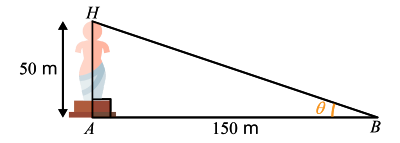
Solution:
The triangle \(\triangle AHB\) creates a right-angle triangle with the statue acting as the opposite. The line \(AB\) is the adjacent and \(BH\) is the hypotenuse. \(\theta\) is the angle of elevation here.
We need to find the angle of elevation. We already have the values for adjacent and opposite. Hence we use the formula for tan \(\theta\) to find the angle of elevation.
\(\begin{align*}\mathrm{tan \,\theta} &= \frac{50}{150}\\\\ &=\frac{1}{3}\\\\ \implies\qquad\theta&=\mathrm{tan^{-1}}\bigg(\frac{1}{3}\bigg)\\\\ \implies\qquad\;\;\; &=18.4848^\circ\\\\ \implies\qquad\;\;\;&\approx 18.4^\circ\ \end{align*}\)
Example 2:
Given that a manhole cover is situated at \(A\), \(62\,m\) away from the foot of a tower. Given that the tower is \(45\,m\) tall, find the angle of depression of the manhole cover from the top of the tower.

Solution:

When we need to find an angle of depression we draw a line, parallel to the base and extend it outwards. In this case, we extend a line from point \(T\) in a straight line. Note that the extended line is now parallel to \(AB\). We see that angle \(\theta\) is the same as angle \(\mathrm{\angle\,{TAB}}\) due to the Alternate Angle property.
Hence you can put it down as ,
\(\begin{align*} \mathrm{tan \;\angle TAB} &= \frac {45}{62}\\ \\ \implies\qquad \theta &= \mathrm{tan^{-1}}\bigg(\frac {45}{62}\bigg)\\ \\ \implies\qquad\;\;\; &=35.97^\circ\\ \\ \implies\qquad\;\;\; &\approx 36^\circ \end{align*}\)
What is Bearing?

A bearing is a measure of the amount of clockwise turn, from the North direction of a fixed point, in degrees.
Bearings are always written as three-digit numbers.
If we were to calculate bearings of \(A\) from \(O\), we would measure it using the angle which the line makes between \(A\) and \(O\) in clockwise direction.

Example 3:
Find the bearings of
- \(P\) from \(O\)
- \(Q\) from \(O\)
- \(R\) from \(O\)
- \(O\) from \(P\)
- \(O\) from \(R\)
Solution:
- \(P\) from \(O =\) As we move clockwise right from \(O\) to \(P\), we need to subtract \(60^{\circ}\) from \(90^{\circ}\).
Thus, the bearing of \(P\) from \(O\) is \(90^{\circ}-60^{\circ}=30^{\circ}\)
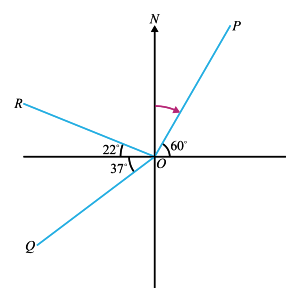
- \(Q\) from \(O =\) As we move clockwise right from \(O\) to \(Q\), we need to subtract \(37^{\circ}\) from \(270^{\circ}\).
Thus, the bearing of \(Q\) from \(O\) is \(270^{\circ}-37^{\circ}=233^{\circ}\).

- \(R\) from \(O =\) As we move clockwise from \(O\) to \(R\), we need to add \(22^{\circ}\) to \(270^{\circ}\).
Thus, the bearings of \(Q\) from \(O\) is \(270^{\circ}+22^{\circ}=292^{\circ}\).
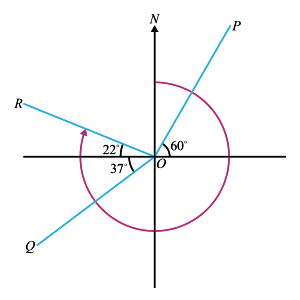
- \(O\) from \(P\) : In this case we draw a set of lines of direction on point \(P\) and as a result, the line pointing north on point \(P\) is parallel to the line pointing towards North at Point \(O\). By the Alternate Angle property, we find the angle \(\theta\), whose value is \(30^{\circ}\).
Therefore the bearing of \(O\) from \(P\) is \(180^{\circ}+30^{\circ}=210^{\circ}\).

- \(O\) from \(R =\) In this case, we draw a set of lines of direction on point \(R\) and as a result, the Line pointing north on point \(R\) is parallel to the line pointing towards North at Point \(O\). By the Alternate Angle property, we find the angle \(\alpha\) whose value is \(22^{\circ}\).
Therefore the bearing of \(O\) from \(R\) is \(90^{\circ}+22^{\circ}=112^{\circ}\).
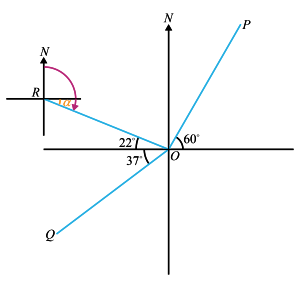
Example 4:
Points \(X\), \(Y\) and \(Z\) are at sea level.
\(X\) is \(60.8 \,m\) away from \(Y\) and \(36.1\,m\) away from \(Z\).
The bearing of \(Y\) from \(X\) is \(99^{\circ}\), the bearing of \(Z\) from \(X\) is \(146^{\circ}\) and the bearing of \(Y\) from \(Z\) is \(63^{\circ}\).
- Calculate \(ZY\).

Solution:
We have the angle where it makes contact with the North direction and line \(XY\) at \(99^{\circ}\), and the angle where it makes contact with the North direction and line \(XZ\) at \(146^{\circ}\)
Hence, for \(\angle ZXY = 146^{\circ}-99^{\circ}=47^{\circ}\)
Since we have two sides and an included angle we can use the cosine rule here.
Thus,
\(\begin{align*} ZY^2 &= XZ^2 + XY^2 -2\times XZ\times XY \times \mathrm{cos} \;\angle ZXY\\ \\ \implies ZY^2 &= 36.1^2 + 60.8^2 -2 \times 36.1 \times 60.8 \times \mathrm{cos} \;47^{\circ}\\ \\ \implies\;\; ZY &= \sqrt {36.1^2 + 60.8^2 -2 \times 36.1 \times 60.8 \times\mathrm{cos} \;47^{\circ}}\\ \\ \implies\;\;ZY&=44.7884^{\circ}\\ \\ \implies\qquad\; &\approx 44.8^{\circ} \end{align*}\)
- Calculate the bearing of \(Z\) from \(Y\).
Solution:
We need to draw our direction to point \(Y\). By the Alternate Angle property, \(\theta = 63^{\circ}\).
Thus, bearing of \(Z\) from \(Y\) \(=180^{\circ}+63^{\circ}=243^{\circ}\)
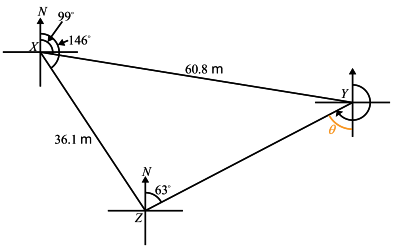
- A boat \(K\) travels in a straight line from \(X\) to \(Y\). Calculate the shortest distance of \(K\) from \(Z\) during this journey.
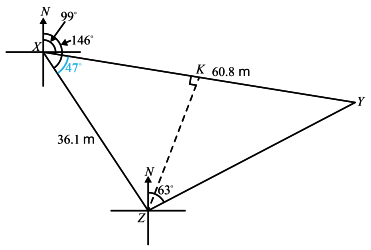
Solution:
The shortest distance for the boat will be along the opposite side of the angle. We already have the angle and the sides.
\(\begin{align*} \mathrm{sin \,47^{\circ}} &=\frac{KZ}{36.1}\\[2ex] KZ&= \mathrm{36.1 \text{ }sin \,47^{\circ}}\\[2ex] &=26.401\\[2ex] &\approx 26.4 \text{ m} \end{align*}\)
Conclusion
In this article, we have discussed the Applications of Trigonometry and how to apply them in solving problems. We discussed the concepts of angles of elevation and depression and understood bearings and how to compute them. These details are aligned to the Secondary 3 Mathematics syllabus prescribed in Singapore.
| Continue Learning | |
|---|---|
| Further Trigonometry | Quadratic Equations And Functions |
| Linear Inequalities | Laws of Indices |
| Coordinate Geometry | Graphs Of Functions And Graphical Solution |
| Applications Of Trigonometry | |


 SG
SG  VN
VN 














